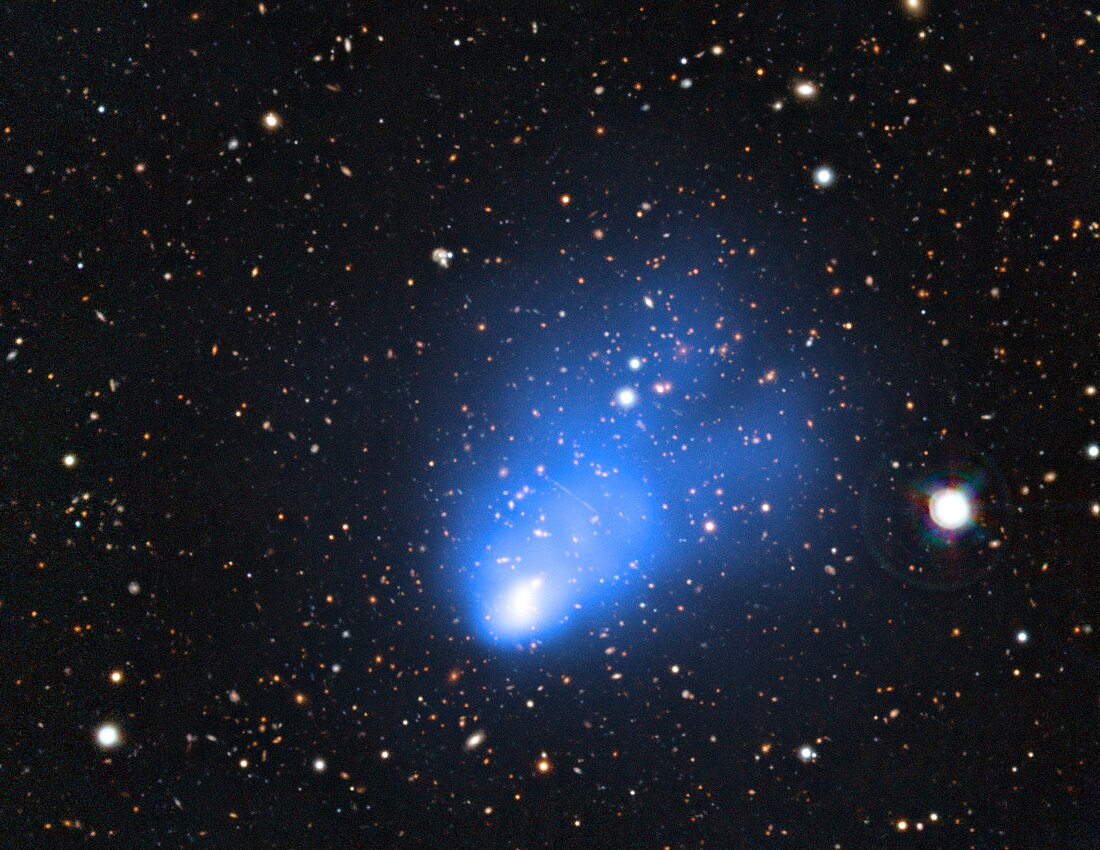Top Qs
Timeline
Chat
Perspective
El Gordo (galaxy cluster)
Largest distant galaxy cluster observed From Wikipedia, the free encyclopedia
Remove ads
El Gordo (lit. The Fat One) (ACT-CL J0102-4915 or SPT-CL J0102-4915) is the largest distant galaxy cluster observed at its distance or beyond, as of 2011. As of 2014, it held the record for being the largest distant galaxy cluster to have been discovered with a mass of slightly less than three quadrillion solar masses[3][4][5][6] although later its mass was reduced to about 2.1×1015 (2.1 quadrillion) solar masses with a 10% uncertainty.[7] It was found by NASA's Chandra X-ray Observatory, the Atacama Cosmology Telescope (funded by the National Science Foundation) and the European Southern Observatory's Very Large Telescope.[8]
This galaxy cluster, officially named as, 'ACT-CL J0102-4915', has been given a 'nickname' by the researchers as 'El Gordo', which stands for "the Fat One" or "the Big One" in Spanish. It is located more than 7 billion light-years from Earth.[9]
Findings and results on 'El Gordo' were announced at the 219th meeting of American Astronomical Society in Austin, Texas.[10]
Remove ads
Observations
Summarize
Perspective
Findings from the European Southern Observatory's Very Large Telescope and the Chandra X-ray Observatory show that El Gordo is composed of two separate galaxy subclusters, colliding at several million kilometers per hour.[11] These observations (using X-ray data and other characteristics) suggest that El Gordo most probably formed in the same manner as the Bullet Cluster (which is located 4 billion light-years from Earth).[12][13][14][15]
Recent radio observations using the uGMRT at frequencies between 300–1450 MHz have provided further insights into El Gordo's complex structure and dynamics. The study revealed a large radio halo extending across the cluster, with spectral characteristics consistent with other high-redshift galaxy clusters. The halo's emission was found to follow a power law between 300–1274 MHz, with steeper spectra observed at higher frequencies. Notably, the radio emission showed spatial variations, with flatter spectral indices in the southern region and steeper values in the north. These findings, combined with X-ray data from Chandra, suggest that the cluster’s radio emissions are intricately linked to its dynamic state, further enhancing our understanding of the interactions between the hot gas and non-thermal components in the cluster's intra-cluster medium.[16]
Remove ads
El Gordo and ΛCDM
It was claimed that this interacting cluster presents problems for the conventional Lambda-CDM model of cosmology because it is hard to reconcile ΛCDM's model of galaxy formation with the combination of how early El Gordo is observed in cosmic history, its large mass, and its high collision velocity.[17] It was argued that later more accurate measurements have rejected this claim and led to a smaller mass estimate fully consistent with the ΛCDM cosmology.[7] However, the claims of consistency with ΛCDM were shown to be due to the assumption of a very low collision velocity that is not supported by any hydrodynamical simulations, not because of the slightly reduced mass estimate, which by itself does not solve the problem.[18]
Remove ads
Gallery
See also
- List of galaxy groups and clusters
- RCS2 J2327, another galaxy cluster being the second-most-massive galaxy cluster at a record of two quadrillion, or two million billion, suns.
References
External links
Wikiwand - on
Seamless Wikipedia browsing. On steroids.
Remove ads




